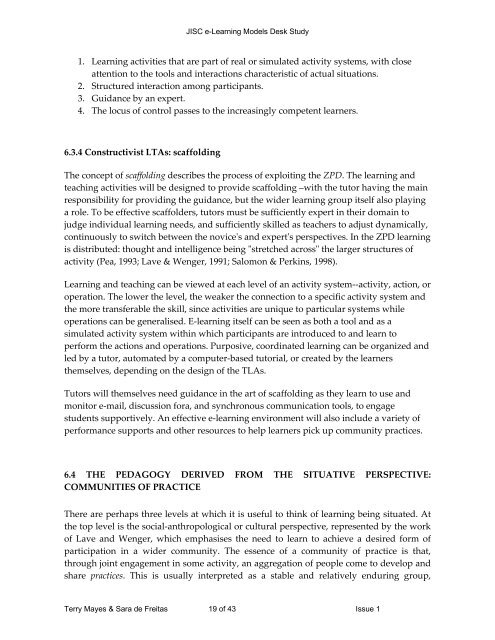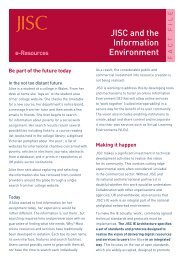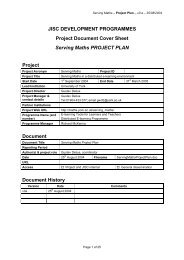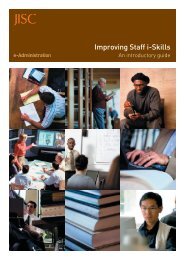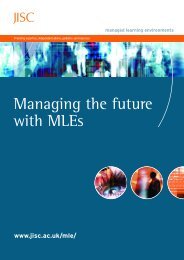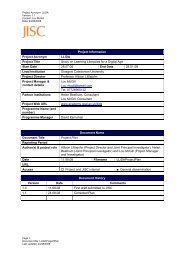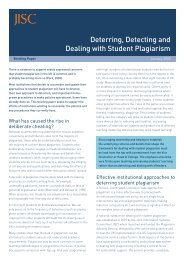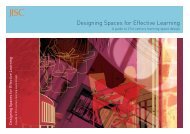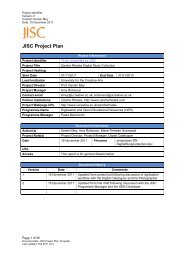Review of e-learning theories, frameworks and models - Jisc
Review of e-learning theories, frameworks and models - Jisc
Review of e-learning theories, frameworks and models - Jisc
Create successful ePaper yourself
Turn your PDF publications into a flip-book with our unique Google optimized e-Paper software.
JISC e-Learning Models Desk Study<br />
1. Learning activities that are part <strong>of</strong> real or simulated activity systems, with close<br />
attention to the tools <strong>and</strong> interactions characteristic <strong>of</strong> actual situations.<br />
2. Structured interaction among participants.<br />
3. Guidance by an expert.<br />
4. The locus <strong>of</strong> control passes to the increasingly competent learners.<br />
6.3.4 Constructivist LTAs: scaffolding<br />
The concept <strong>of</strong> scaffolding describes the process <strong>of</strong> exploiting the ZPD. The <strong>learning</strong> <strong>and</strong><br />
teaching activities will be designed to provide scaffolding –with the tutor having the main<br />
responsibility for providing the guidance, but the wider <strong>learning</strong> group itself also playing<br />
a role. To be effective scaffolders, tutors must be sufficiently expert in their domain to<br />
judge individual <strong>learning</strong> needs, <strong>and</strong> sufficiently skilled as teachers to adjust dynamically,<br />
continuously to switch between the noviceʹs <strong>and</strong> expertʹs perspectives. In the ZPD <strong>learning</strong><br />
is distributed: thought <strong>and</strong> intelligence being ʺstretched acrossʺ the larger structures <strong>of</strong><br />
activity (Pea, 1993; Lave & Wenger, 1991; Salomon & Perkins, 1998).<br />
Learning <strong>and</strong> teaching can be viewed at each level <strong>of</strong> an activity system--activity, action, or<br />
operation. The lower the level, the weaker the connection to a specific activity system <strong>and</strong><br />
the more transferable the skill, since activities are unique to particular systems while<br />
operations can be generalised. E-<strong>learning</strong> itself can be seen as both a tool <strong>and</strong> as a<br />
simulated activity system within which participants are introduced to <strong>and</strong> learn to<br />
perform the actions <strong>and</strong> operations. Purposive, coordinated <strong>learning</strong> can be organized <strong>and</strong><br />
led by a tutor, automated by a computer-based tutorial, or created by the learners<br />
themselves, depending on the design <strong>of</strong> the TLAs.<br />
Tutors will themselves need guidance in the art <strong>of</strong> scaffolding as they learn to use <strong>and</strong><br />
monitor e-mail, discussion fora, <strong>and</strong> synchronous communication tools, to engage<br />
students supportively. An effective e-<strong>learning</strong> environment will also include a variety <strong>of</strong><br />
performance supports <strong>and</strong> other resources to help learners pick up community practices.<br />
6.4 THE PEDAGOGY DERIVED FROM THE SITUATIVE PERSPECTIVE:<br />
COMMUNITIES OF PRACTICE<br />
There are perhaps three levels at which it is useful to think <strong>of</strong> <strong>learning</strong> being situated. At<br />
the top level is the social-anthropological or cultural perspective, represented by the work<br />
<strong>of</strong> Lave <strong>and</strong> Wenger, which emphasises the need to learn to achieve a desired form <strong>of</strong><br />
participation in a wider community. The essence <strong>of</strong> a community <strong>of</strong> practice is that,<br />
through joint engagement in some activity, an aggregation <strong>of</strong> people come to develop <strong>and</strong><br />
share practices. This is usually interpreted as a stable <strong>and</strong> relatively enduring group,<br />
Terry Mayes & Sara de Freitas 19 <strong>of</strong> 43 Issue 1


